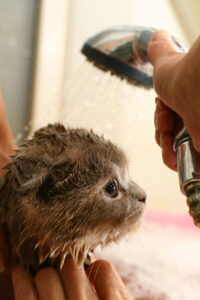Have you ever thought that bathing your cat was an impossible task? For a moment, the idea that you might be taking your life into your own hands could have flashed through your mind. Here Dr. Ava Frick tells us some easy steps to help make bathing our cats easier and how it can help provide them with a healthier and happier life.
Bathing a cat can be simple but there are several points that should be in place and items that will make this experience less traumatic. Your supply list includes:
1 long sleeved shirt with buttons
Toenail clippers (the ones you use for your toe nails will work too)
Vaseline for the eyes
1 cotton ball
1 sponge
3 pitchers (2 full of warm water, 1 empty)
Hypoallergenic, chemical-free conditioning shampoo (See compatible options here)
2 Q-tips and some alcohol
2 towels
1 hair blow dryer
A warm sunny spot to complete the drying process
Start with putting on a long sleeve shirt and button the cuffs. The method to this is that if kitty decides to try and escape, and reaches for you, the claws will grab the shirt and not your skin. Split the cotton ball and put half in each ear. Apply a small bleb of Vaseline to each eye to protect against any soap that may get in them. It is best to put it in the corner of the eye and then close the lids and gently massage to disperse.
 Check the shampoo for consistency. If it is too thick you may dilute some into a smaller squeeze bottle. This saves on product and makes the rinse cycle go easier. Fill a tub with warm water along with 2 pitchers for rinsing. Save the third pitcher for the initial dirty rinse. Do not turn the faucet on while the cat is in the sink. Water rushing out of the faucet will send them out faster than you can blink.
Check the shampoo for consistency. If it is too thick you may dilute some into a smaller squeeze bottle. This saves on product and makes the rinse cycle go easier. Fill a tub with warm water along with 2 pitchers for rinsing. Save the third pitcher for the initial dirty rinse. Do not turn the faucet on while the cat is in the sink. Water rushing out of the faucet will send them out faster than you can blink.
Now you are ready to put kitty into the sink container and use the empty pitcher to rinse. Start with legs and body leaving the head for last. Lather, scrub gently, and massage those tired muscles. Now lightly use 1-2 fingers to lather the head avoiding eyes and inside the ears.
To begin rinsing, use the water he has been sitting in to do the first pass. Follow with those pre-filled pitchers. Do not pour water onto the face but use the sponge instead to direct water flow and remove the soap, avoiding the eyes. Once the soap has been washed away, wrap kitty up in towel #1. Compress the towel to pull the water from his fur. Repeat with towel #2, rubbing as you go. Turn on the hair dryer, holding it away from kitty, and check a tolerance level. Introduce gradually, getting closer and closer. Use the dryer to remove the majority of the moisture.
Moisten the Q-tips with alcohol and clean wax and dirt from the ears. Only get where your eyes can see; do not go further into the ear canal than what you can actually see. Wipe the eyes of any residual Vaseline. Comb out remaining mats, finishing with an after-bath conditioner if needed.
Last step is the nail trim. Older cats generally have overgrown nails due to lack of use. They are much easier to trim than a dog’s nails, as they are separated into very thick and thin sections. Trim off the narrow sharp points while avoiding the thick base.
Put kitty in a warm isolated place to finish preening. Repeat this process up to twice a month as needed to keep the senior citizen cat dandruff free and comfortable.
Ava Frick, DVM, CAC
Pet Rehab & Pain Clinic
Chesterfield, MO
www.animalrehabstlouis.com


 Translate
Translate
